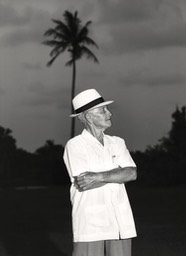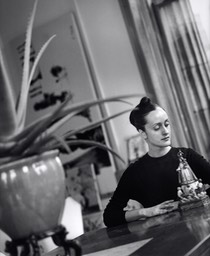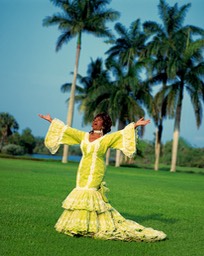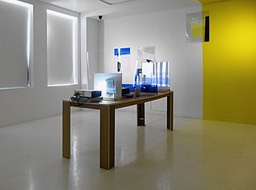Listen to commentaries associated with the story.
Photos courtesty Alexis Rodriguez-Duarte and Tico Torres
The re-opening of the elegantly restored Freedom Tower at 600 Biscayne Boulevard, now housing Miami Dade College’s Museum of Art + Design (MOAD) plus the Miami International Film Festival and MDC Live Arts performance center couldn’t be fully celebrated in a single event.
The inaugural exhibitions, The Exile Experience: Journey to Freedom plus Cuba Out of Cuba: Through the Lens of Alexis Rodriguez-Duarte in Collaboration with Tico Torres commemorate the landmark building, document the dramatic saga of Cuban refugees’ arrival in Miami and celebrate the lives they have created outside the island.
Jeremy Mikolajczak, MOAD’s executive director and chief curator, said that with the Sept. 10 opening of exhibitions in the new history-oriented galleries, the museum is fulfilling another aspect of its mission. “We’re enhancing what the intent of the building is.”
The Cultural Legacy Gallery will rotate exhibitions once a year, while the Exile Experience Gallery installation, which will focus on a different aspect of immigration, will install new exhibits every two years.
On Sept. 14, four more exhibitions opened in conjunction with Dwntwn Art Days and MOAD’s new season of activities. An expansive and high-caliber exhibition by instructors from all six Miami Dade College campuses presents some great talents to one another and to the public. “LEBO” Le Batard, best known for his pop and graffiti-based mural work, presents more intimate works in an unexpectedly restrained palette. He also unveiled his poster design for this year’s Miami Book Fair International. Asser Saint-Val’s paintings explore the dynamics of skin color and the under-recognized inventions of people of the African Diaspora. Additionally, during the book fair, he will present his floating sculptural “Philosopher’s Stone.”
Many of the first-night invitees were Cuban Americans eager to revisit the site of their arrival decades earlier. They found the mezzanine level – already remarkable for its elegant grandeur and 40-foot-wide New World mural – freshly outfitted with panels and vitrines in symmetrical exhibitions that portray the building’s history – and their own. Notably, Miami Dade College’s president Eduardo Padrón is quoted on one of the panels, “I remember thinking it was the most beautiful building I had ever seen. I understood it wasn’t really the Statue of Liberty, but I knew then it would be mine.”
The Exile Experience
Luisa Yanez, co-created this commemorative exhibition with Miami Herald interactive editor Nancy San Martin and graphic artist Ana Larrauri in partnership MOAD and the Miami Herald Media Co. Yanez, a former reporter for both the Miami News and Miami Herald, is now a Herald editorial writer. She and her parents came to Miami in the late ’60s: “Life changed so radically for Cubans in 1959 when Fidel Castro took over. You escaped Cuba, and this is the building that you had to run to in the United States,” she said. “It's a building with such character that you remember walking in here.”
Photojournalistic collages of images, captions and quotations are printed on aluminum panels, while artifacts and documents are enclosed in glass cases. They vividly trace the Cuban exile experience in two “streams.” One array, called Pedro Pan, installed on the north side of the first floor, portrays the dramatic and perilous airlift rescue of more than 14,000 Cuban children. Its counterpart on the south side, portrays the tower’s history and documents the experiences of thousands of Cuban refugees who relied on the facility and its staff for critical assistance.
History
The tower has seen glory days and somber days. Former Ohio governor James Cox wanted a proud and forward-looking building for his new publication, The Miami Daily News-Metropolis.
His elegantly detailed 1925 Mediterranean Revival style building, topped with an octagonal tower was grand and well-proportioned. The 1926 hurricane knocked the structure atilt – the storm was that powerful and destructive – but rebuilt, it served the rapidly growing metropolis of Miami and stood as a picturesque downtown icon.
Howard Kleinberg started there in 1949 as a teenage sports reporter and worked his way up the management ladder. But he described it as a “horror” to work in. With no air conditioning, staffers had to leave the windows open. Mosquitoes were a plague. “And when it rained – we had these thunderous storms – you had to cover things up on your desk,” he recalls.
Also, transport and parking had become major headaches. In 1957, “It was a very happy day when we moved out.” Everyone was grateful to move into a new air-conditioned building near the Miami River. For a few years, the Miami News Tower was empty, dubbed “the dowager on the Boulevard” by women’s editor, Agnes Ash.
El Refugio
Fidel Castro’s seizure of government and property in 1959 sparked an exodus of Cubans and led to the tower’s second life as a portal of welcome and a processing center. As the influx of refugees overwhelmed a first welcome center, the U.S. government leased the tower in 1962, and converted it to its Ellis Island-like function. It was popularly called El Refugio – The Refuge. Yanez explained: “So, the refugee family would arrive. They would be processed. If they were Catholic, they were sent to the Catholic services. If they were Jewish, they would be sent to the Jewish agency. There, it would be decided if you had been claimed by a relative who lived in New Jersey, that's where you were going to be relocated if you wanted to keep the government assistance that was offered to you.”
That assistance consisted of medical and dental services, food and logistical help – even tickets to resettle in other parts of the country. Various religious, humanitarian, religious and governmental agencies greeted and registered the newcomers.
The irony of the tower’s re-purposing wasn’t lost on Kleinberg – by then, news editor across town. “The building that Cox built [modeled] after a tower in Spain was now a bastion of liberty for those who spoke Spanish,” he said.
Artist and curator Angela Valella arrived with her family in February 1969. Cuban refugees were not required to stay in Miami, and Valella’s mom didn’t want to. She met with American officials. “They gave her a map of the U.S. and told her, ‘Where do you want to go?’ She closed her eyes and put her finger [on the map] and we ended up in Rhode Island. Then the Catholic Charities brought us to New York. … It was our life according to her finger.”
Émigrés often arrived destitute – everything having been confiscated in Cuba. They came to the Freedom Tower for financial assistance until they could find work. They also received canned meat, American cheese, peanut butter, lard, powdered milk and other staples, which they “latinized” at home.
As a young teenager, Valella had her first chocolate and first chewing gum in the building. She and her sister also encountered a vending machine. “We didn’t know what to do, so we were talking to the machine. We told the machine we need this and that.” A security guard explained, “Push the buttons!”
Casual and dramatic photos are accompanied by informational captions, personal anecdotes and quotations by politicians, artists and religious leaders.
“We wanted this mix between having a historical perspective, but also telling this humanistic side, and that’s something the media, the newspapers of the time did a fantastic job in portraying, said Mikolajczak.
The exhibition organizers put out a call to the exile community to cultivate tie-in and to solicit objects. More will follow. “We've collected memorabilia from that time. We opened the doors on a Saturday for people to bring their refugee cards, the clothes that they wore, a doll [that] a little girl carried. It was a very emotional event for many people,” said Yanez. One display case contains the list of clothing items that the Castro government allowed refugees to take with them.
In the ’60s, Luisa Meruelo interviewed new arrivals and saw so much heartbreak. She is quoted on one of the panels. “The planes would land, and then the refugees would be transported to the tower. They would arrive disoriented and defeated, having just left everything they knew behind. I tried to help them as much as I could.” She had learned English in Cuba and was able to speak with her countrymen in Spanish while compiling official documents in English.
Pedro Pan
Not everyone came in family groups. Castro’s use of schools as tools for communist indoctrination and his efforts to switch children’s allegiance from their parents to the State, provoked great alarm and sparked the formation of a clandestine conduit of escape that was dubbed Operation Pedro Pan. Between January 1960 and October 1962, more than 14,000 unaccompanied children flew to Miami using special visa waivers, implemented by the State Department and accepted by the Cuban government.
Father Bryan Walsh and his Catholic Welfare Bureau staff – along with volunteers – welcomed the children and placed them in group housing camps. Many were then taken in by families – regionally and across the country – awaiting eventual reunion with their birth families. Walsh is quoted in one of the panels, “You’ve come to a place where people care about you, there’s nothing to worry about. Until your parents come for you, you’ll have a home with us.”
As a child, architect Carmen Valdivia stayed at the Florida City Camp for three years, and her photos are included in the panels. She is president of the Operation Pedro Pan Group, an organization whose members document and disseminate the history of the operation, assist needy children and help reunite “alumni.”
The Miami Herald/El Nuevo Herald maintains a searchable online database for family and friends of Pedro Pan. bitly.com/PedroPanLookup
Cuba Out of Cuba
A “boutique” gallery, also on the first floor, houses Cuba Out of Cuba: Through the Lens of Alexis Rodriguez-Duarte in Collaboration with Tico Torres. For two decades photographer Alexis Rodriguez-Duarte and his collaborator, art director/stylist Humberto “Tico” Torres have been capturing remarkable images of Cuban émigrés. Many, such as Celia Cruz, “Cachao” López, José Bedia, Guillermo Cabrera Infante, Andy Garcia, Gloria and Emilio Estefan, Cristina Saralegui and Isabel and Ruben Toledo, are internationally recognized in their creative fields. The photographs are hung salon style in thematic groupings. Duarte and Torres have continued this project in conjunction with lifestyle publication assignments and as an independent venture.
Visitors are greeted by a black-and-white photo of an elderly gentleman. It’s Rodriguez-Duarte’s grandfather, brilliantly illuminated against a dark wall of trees at Fairchild Tropical Botanic Garden. As Torres explained, he's wearing Gianfranco Ferré pants, a Borsalino hat and his own guayabera. The distinctive attire allowed them to use this special model and still create a stylish image for their Italian fashion magazine client. Rodriguez-Duarte spoke with a catch in his throat. “He's no longer with us, but that moment I captured, that represents not only my own grandfather, but every Cuban grandfather.”
Another photo, also taken at Fairchild, captures the exuberant “Queen of Salsa” in vivid color and serves as the cover of Rodriguez-Duarte and Torres’ book, Presenting Celia Cruz.
The pair, who were married in New York, embodies the classic immigrant story of “making good” through skill and enterprise. They both left Cuba as children in the late ’60s and have preserved photos, first cameras, toys, clothing, etc., which they display in a pair of vitrines.
In another dream fulfilled, Rodriguez-Duarte provided his father the chance to view the photo of his father in this celebrated venue.
Mikolajczak said, “One thing that’s great about Alexis and Tico: They’re very indebted to their community, but also feel very strongly about this preservation that needs to be told on a continual basis.”



